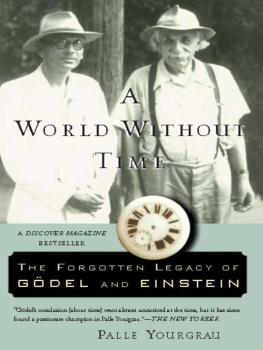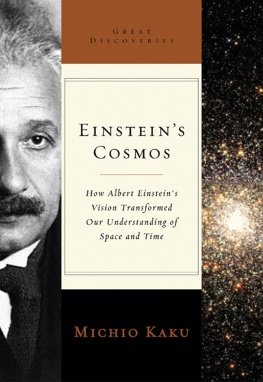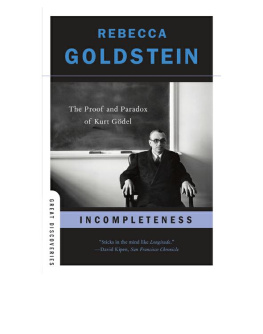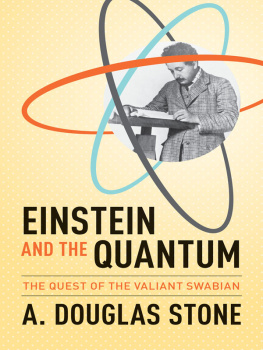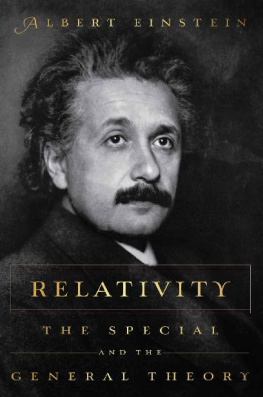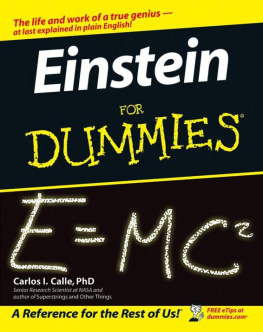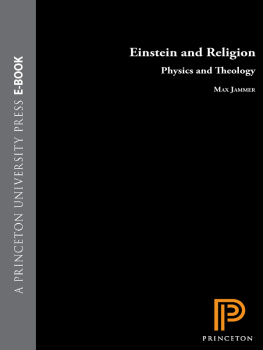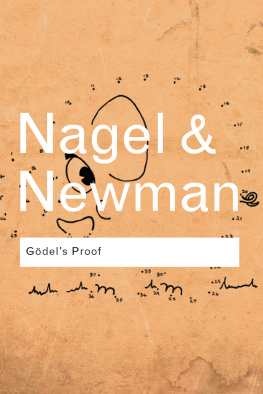All rights reserved. Printed in the United States of America. No part
of this book may be reproduced in any manner whatsoever without
written permission except in the case of brief quotations
embodied in critical articles and reviews.
A CIP catalog record for this book is available from the Library of Congress.
HC: ISBN-13 978-0-465-09293-2; ISBN-10 0-465-09293-4
ACKNOWLEDGMENTS
Having already written a book intended primarily for philosophers about Kurt Gdels attempt to make sense of Einsteins theory of relativity, I was intrigued when William Frucht of Basic Books suggested I write another, this one accessible to normal readers. Such a book would focus on the sheer intellectual drama of the companionship of Gdel and Einsteina relationship sorely neglected in the literature and would place Gdels and Einsteins epoch-making discoveries in the context of the great intellectual movements of the twentieth century, some of which, having helped to father, they tried, belatedly, to abandon. It was an offer too good to refuse, and I didnt. The task, however, turned out to be far from easy, and Frucht had to endure not only the late delivery of the final manuscript, but the drumbeat of my complaints about his editorial adventures at the expense of my beloved prose; it may not have been much, but it was all mine. I am grateful to Frucht both for the initial invitation and for (what turned out to be) his wise editorial advice, at every stage, on how to improve the manuscript.
I have greatly benefited from discussing the book with Mary Sullivan and Ben Callard. Sullivan, attentive as ever to the task of trying to keep me honest, read large parts of the book and offered acute, sobering advice, which I took to heart. Callards critical remarks on every chapter were of great value and are reflected in the final draft. His strange affection for the work, moreover, kept my spirits up during the many dark moments when the project seemed to me ill-advised and misbegotten. Mark van Atten also read the entire manuscript. His extraordinarily detailed remarks, on both substance and style, were a great boon. Robert Tragesser shared with me his deep understanding of Gdels theorem, and Eli Hirsch helped make certain that my discussions of logic and mathematics were clear, accessible, and to the point. To each of these I owe a serious debt of gratitude, but especially to Callard and van Atten, for their extensive and thoughtful comments.
I would also like to express my appreciation for the conversations I had over a period of years with the late Hao Wang, of Rockefeller University, whom I came to know when I taught at Barnard College in New York. With Wang, who was one of Gdels closest associates in his final years, I spent endless hours discussing Gdels ideas, published and unpublished. The question of time was of particular interest to him. He confessed that, finding the topic uncongenial, he had resisted Gdels efforts to discuss his thoughts on this theme, and regretted it. I regretted it, too. It did not diminish, however, the fruitfulness of our conversations, nor the enjoyment we took in contemplating what Gdel has said and written.
In addition to help from my friends, I have also depended on the kindness of strangers. My copy editor, David Kramer, in addition to improving the clarity and flow of the text, made a number of comments and suggestions of a more substantial nature on a wide variety of topics, from music to mathematics, which were an unexpected gift. AnnaLee Pauls, photoduplication coordinator at the Rare Books and Special Collections department of Princeton Universitys Firestone Library, provided much needed assistance in the delicate task of choosing and reproducing the right photos from the Gdel archives, housed in Firestone Library. I am grateful both for her assistance and for the spirit with which she provided it. I would also, finally, like to thank Arudra Burra, who is not a stranger, for his generous help, combined with fine judgment, in the search for the right photos to include in the book.
A WORLD WITHOUT TIME
1 | A Conspiracy of Silence
Gdel was... the only one of our colleagues who walked andtalked on equal terms with Einstein.
FREEMAN DYSON
In the summer of 1942, while German U-boats roamed in wolf packs off the coast of Maine, residents in the small coastal town of Blue Hill were alarmed by the sight of a solitary figure, hands clasped behind his back, hunched over like a comma with his eyes fixed on the ground, making his way along the shore in a seemingly endless midnight stroll. Those who encountered the man were struck by his deep scowl and thick German accent. Speculation mounted that he was a German spy giving secret signals to enemy warships. The dark stranger, however, was no German spy. He was Kurt Gdel, the greatest logician of all time, a beacon in the intellectual landscape of the last thousand years, and the prey he sought was not American ships bound for Britain but rather the so-called continuum hypothesis, a conjecture made by the mathematician Georg Cantor about the number of points on a line. Gdel was spending the summer vacationing at the Blue Hill Inn with his wife, Adele, although fellow visitors at the inn rarely saw either of them. They materialized for dinner, but were never observed actually eating. To the locals, Gdels scowl betrayed a dark disposition, but the innkeeper saw things differently. For her it was the expression of a man lost in thought. His last word to Blue Hill would not decide the issue. He sent a letter accusing the innkeeper of stealing the key to his trunk.
The place Gdel would return to in the fall was a long way from Blue Hillthe prestigious Institute for Advanced Study in Princeton, New Jersey. There he would no longer have to walk alone, arousing the suspicions of neighbors. He had a walking companion, a colleague at the institute and his best friend. There was no danger that his reputation would intimidate his companion. For his friend, another German-speaking refugee with a mathematical bent, was the most famous scientist of all time, Albert Einstein, whose own meditative strolls already irritated the residents of Princeton.
From a distance, a biographer wrote, the [residents of Princeton] chuckled discreetly over [Einsteins] habit of licking an ice cream on Nassau Street on his way home from Fine Hall and were astonished by his utterly un-American long walks through the streets of Princeton. Indeed, toward the end of his career, when he was more or less retired, Einstein commented that his own work no longer meant much to him and that he now went to his office just to have the privilege of walking home with Kurt Gdel. Ironically, it was not the scowling Gdel but his smiling companion who had once given indirect aid to the German U-boats, when, during World War I, although a courageous and committed pacifist, Einstein had helped improve the gyroscopes used by the German navy. Gdels research would also, in the end, relate to gyroscopes, but these spun at the center of the universe, not in the dank bowels of submarines.

